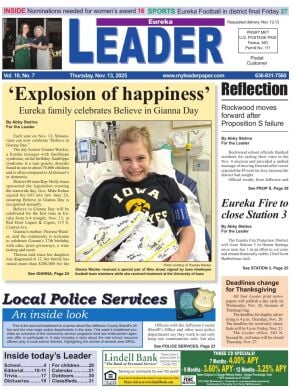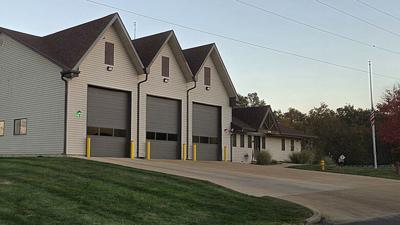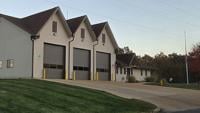The Eureka Fire Protection District will close Station 3 in Hoene Springs on or near Jan. 1 in an effort to cut costs and remain financially stable, Chief Scott Barthelmass said.
The district will not sell the Station 3 property at 3570 White Oak School Road, and the personnel stationed there and the equipment housed there will be relocated to the district’s two other stations, which are at 4849 Hwy. 109 and 1815 W. Fifth St.
Barthelmass said the district held an informational meeting with Hoene Springs residents on Nov. 3 to discuss the station’s impending closure. He said about 20 people showed up for the meeting.
“People had a lot of questions, and we were able to answer them,” Barthelmass said. “Residents did express their concern with the engine house being closed but seemed to understand the current fiscal situation of the fire district.”
Barthelmass said the Eureka Fire Board of Directors voted unanimously on Oct. 27 to close the station. The decision was made after Proposition F, a 34-cent tax increase measure, failed to pass in both the April and August elections.
If voters had approved the measure, the additional revenue would have been used to raise salaries, purchase new equipment and fund building repairs.
While the tax increase did not pass, Barthelmass said in an Oct. 28 statement that the district’s costly equipment, building and personnel needs remained. Emergency call volume is also expected to increase by 5 percent districtwide this year, he said.
“After the failure of Proposition F (in August), the district engaged in more than two months of conversations, budget analysis and extensive research to find a pathway forward to best serve the entire community while remaining fiscally responsible to be able to address our needs,” he said. “The area served by Station 3 accounts for less than 4 percent of the total calls for service the district responds to. In total, in four years, Station 3 has responded to 1,224 calls; Station 1 responded to 7,396 calls during that same time period; and Station 2 responded to 6,261 calls during that same time period.”
Barthelmass said he doesn’t foresee having to rely more heavily on surrounding fire and ambulance districts to provide mutual aid once the station closes because the High Ridge and Cedar Hill fire protection districts, along with the Big River Ambulance District, already regularly provide mutual aid when calls come in for the Hoene Springs area.
The district is keeping Station 3 in the event that flooding isolates the area, Barthelmass said. Staff and equipment will be moved to the station to ensure coverage of the area.
Station 3’s ladder truck will be moved to Station 2. The tanker truck will be moved to Station 1, “where it can still respond to calls off Hwy. FF in Hoene Springs, in Allenton and off Lewis Road,” all considered areas with limited or no fire hydrants.
Barthelmass said six of the station’s firefighter/paramedics will be relocated to Station 1 and 2, adding that the move will ensure full staffing at the two stations and alleviate safety concerns the district has had for several years because of understaffing at those houses.
Three firefighter/paramedic positions will be eliminated through attrition with the closure, meaning the district will not hire for those positions once the firefighters retire.
Deputy Chief William Stamberger will retire on Jan. 5, 2026, and Battalion Chief Brian Callahan will retire in February. Barthelmass said their positions will not be filled.
Nick LaRosa of Fenton was recently hired to fill the assistant chief position that was vacated when Barthelmass was promoted to chief last year. LaRosa began at Eureka Fire on Oct. 31.
“He has 35 years of experience in public safety and fire safety, with the last 25 years spent at the Mehlville Fire Protection District,” Barthelmass said.
Other cost-saving measures
In the release, Barthelmass listed the district’s other plans to reduce costs:
■ Selling a Chevrolet Tahoe as a result of eliminating two command staff positions.
■ Selling a reserve ladder truck and engine as surplus once the district’s new rescue pumper arrives, which Barthelmass expects to be delivered in December.
■ Seeking new bids from numerous services to find cheaper options. Barthelmass said this year the district switched short-term, long-term and life insurance providers from Standard Insurance Co. to Met, saving the district about $2,500 a month.
■ Pulling back on supporting regional initiatives, such as sending firefighters to help with natural disaster response in other parts of the state.
■ Adjusting fees for calls where medical care is provided but patients are not transported to a hospital.
“This will allow for the recoupment of costs related to those calls,” Barthelmass said. “As with other EMS calls, we will only bill the insurance provider for these calls, not the resident.”
■ Increasing costs for reports and information requests to better reflect the labor costs to gather and print the information.
■ Investing funds reserved for the purchase of the new pumper truck. The delivery of the truck has been severely delayed since the district ordered it in September 2023, Barthelmass said. Those invested funds have raised about $65,000 for the district, allocated for capital expenses.
■ Implementing a new cash flow management program with the Missouri Capital Asset Advantage Treasury (MOCAAT) investment service, based in St. Louis. Most of the tax revenue for the district comes in from December through February, meaning some of those funds wouldn’t usually be touched until October or November of the next year, Barthelmass said.
He said the district has budgeted $200,000 in estimated revenue from the program.
“We’ve taken all our tax money, typically December through February or so, and then (MOCAAT) will take that and invest in, for example, CDs (certificates of deposit) or the like – things with security, liquidity and investment potential. Then we use that money, so it’s not sitting there.”
■ “Aggressively seeking” grant funding, said Barthelmass, who added that it’s becoming harder and harder to receive grant funding.
“In today’s economic climate, the process to obtain grant funding is highly competitive,” he said. “Additionally, it is not a consistent source of revenue.
“The district will continue to provide the best fire, EMS, rescue and hazmat service to our community. Thank you for your trust and confidence in the Eureka Fire Protection District.”




